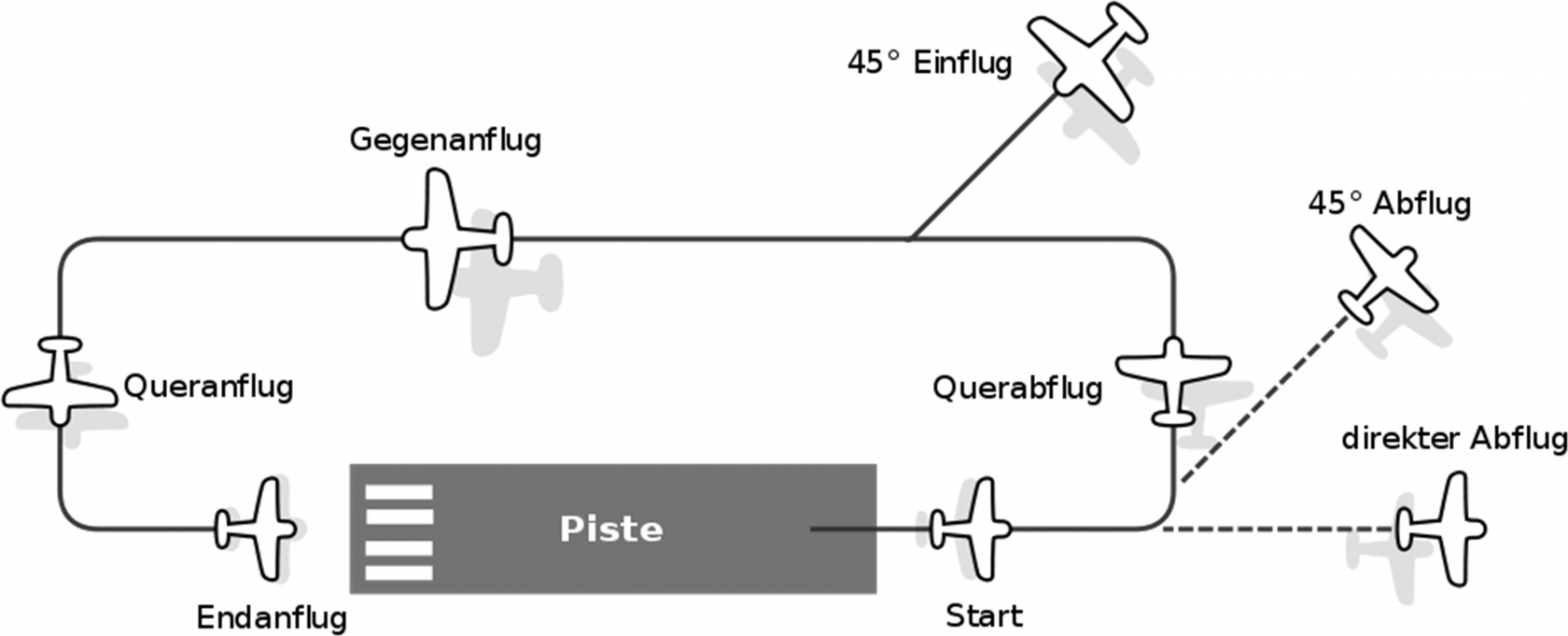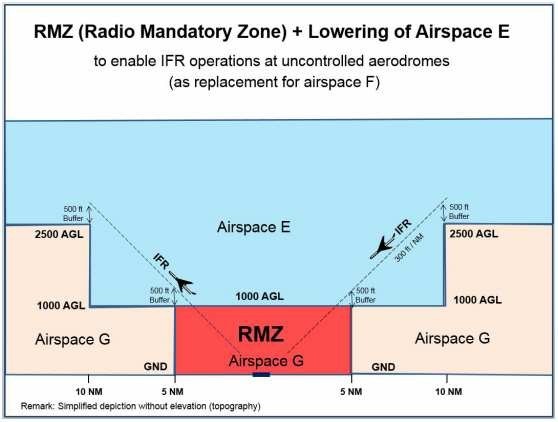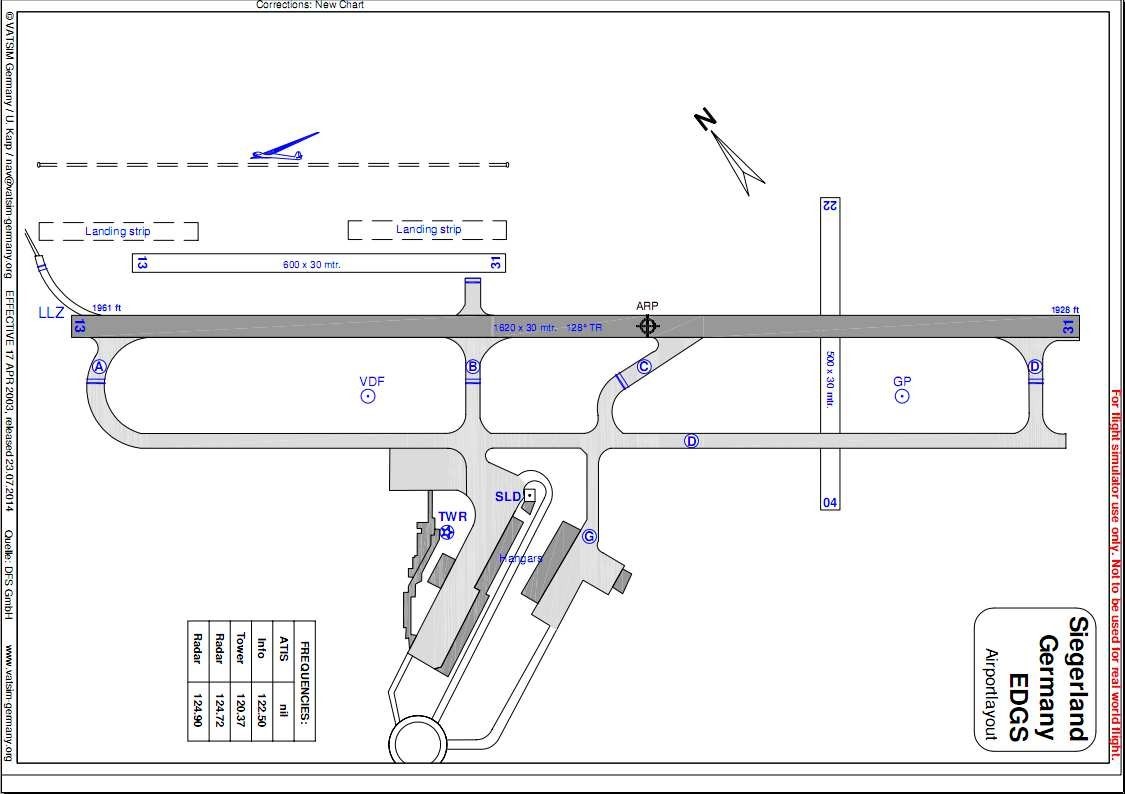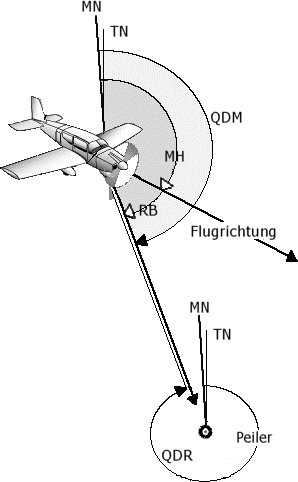Uncontrolled airfield
Introduction
After receiving your student rating, you will next receive training for the Aerodrome Flight Information Service (AFIS) and then permission to provide AFIS within vACC Germany. This manual will support you in this process.
This guide has been kept as general as possible. Nevertheless, it is sometimes necessary to use examples that are handled slightly differently in different FIRs.
Aims of this guide
We will cover all the duties that a AFIS controller of vACC Germany has to fulfill. This ranges from distributing the correct traffic information to forwarding IFR clearances that you receive from air traffic control units.
This guide will also provide you with information on what service is expected from AFIS stations and the limitations of an AFIS in terms of clearances and/or instructions to air traffic.
Uncontrolled airfields
The term "uncontrolled" refers to the service provided at airfields without Air Traffic Control (ATC) but with AFIS.
Surrounding airspace
Uncontrolled aerodromes in Germany are located in airspace G, in which VFR and IFR traffic has been permitted due to the introduction of SERA (Standardized European Rules of the Air) in December 2014. At airfields that have IFR approach and departure procedures, a Radio Mandatory Zone (RMZ) has been established around the airfield, in which pilots must comply with the visual minima of airspace G and also are required to be ready to make and receive radio calls on the RMZ frequency at all times. The frequency is usually the radio frequency of the airfield. At airfields with IFR traffic, airspace E is also lowered to 1,000ft AGL.
Uncontrolled airfields without IFR procedures normally bear the name of the town nearest to the airfield and the suffix "Radio". For example, the airfield near Mainz has the call sign "Mainz Radio". Exceptions to this rule can be found on the VFR charts for the respective airfield and in the AIP Germany.
Ground layout
The layout of larger airfields is similar to that of airfields with air traffic control centers, where one or more runways are connected to an apron by taxiways. The picture above shows the layout of Siegerland Airport, an uncontrolled airfield with IFR traffic.
Smaller airfields with a grass airstrip only may not even have designated taxiways at all. In this case, pilots will indicate which side of the runway they will be taxiing to when announcing their taxiing intentions:
| Rollen / Taxi | |
| DELFE, rolle zum Rollhalt Süd Piste 25 | DELFE, taxiing to holding point south runway 25 |
Traffic circuit
The traffic circuit is an obligatory procedure for aircraft to keep separation from each other during approach and departure. The traffic circuit has an assigned altitude, usually 1000ft AGL. The route resembles a rectangle and is standardized with left turns after departure. For noise protection reasons etc exceptions are possible but are then noted on the corresponding charts. Traffic circuits are a standard method for pilots to assume the pattern altitude and then plan their approach to the active runway in order to perform a full stop landing or a touch and go. During upwind and crosswind, the aircraft will climb to the pattern altitude and enter downwind to line up for an approach to the active runway. The pilot will begin to configure the aircraft for the approach, reduce altitude and assume the glide path to the threshold either on downwind or base.
At all airfields approved as at least a "Sonderlandeplatz" (German legal term, means "special airfield"), the traffic circuit is shown on the VFR approach charts (VAC) and pilots are required to follow it. However, pilots may deviate from the traffic circuit if the flight path so requires.
Where no traffic circuits are specified, the pilot can determine their route at their own discretion and take minimum safety altitude and noise protection procedures into account.
 Components of a traffic circuit
Components of a traffic circuit
The English terms for the elements of a traffic pattern are:
| English | German |
| Departure | Abflug |
| Crosswind | Querabflug |
| Downwind | Gegenanflug |
| Base | Queranflug |
| Final | Endanflug |
If no traffic circuit is established in the VAC, the standard traffic circuit is flown with left turns. Right turn traffic circuits only exist if they are published on the charts. If both version of a traffic circuit are published, the flight director will follow the AIP of the aerodrome. On VATSIM you should fly according to the charts. If both traffic circuits are published, the VATSIM flight director may decide.
AFIS preparation
Similar to controlled aerodromes, the active runway must be selected considering various factors such as weather and local regulations.
Please keep in mind that the active runway notification is only a guideline for the pilot, who may only deviate from it for valid reasons, i.e. to keep the flight operations safe. Most uncontrolled airfields do not have certified equipment for determining barometric pressure. In this case, the pilot is responsible for obtaining the QNH. For example, they can set the altimeter to display the altitude of the airfield MSL.
A general rule AFIS states that neither clearances nor instructions may be issued to aircraft unless there is a danger to flight safety or the given circumstances threaten the safety of aircraft or persons on the ground. This rule does not apply to movements on the ground, where the aerodrome operator may have delegated the aerodrome authority to the air traffic controller who can then determine which areas must be used for taxiing and other ground movements.
Initial call
VFR traffic approaching or departing an uncontrolled aerodrome is obliged to establish radio communication on your frequency. The initial call always has the same structure:
| Erstanruf / Initial Call |
|
| Speyer Radio, DEDFS |
Speyer Radio, DEDFS |
| DEDFS, Speyer Radio |
DEDFS, Speyer Radio |
Approaching traffic
After the initial call, approaching traffic will communicate their call sign, aircraft type, current position (in NM, including altitude) and its intentions. As the so-called main flight log of the respective landing site is usually kept via radio at uncontrolled airfields, the aircraft commander will also state the departure location and the number of persons on board during the initial call. Information relevant to approaching traffic is the runway and other flight operations information that is useful for a safe landing (e.g. heavy traffic, glider/ aerobatic operations, runway conditions, etc.).
| Anfliegender Verkehr / Approaching Traffic |
|
| DEDFS, C172, VFR aus EDWE 8 Meilen südlich des Platzes, 2.200ft, zur Landung. | DEDFS, C172, VFR from EDWE, 8 miles south of field, 2.200ft, for landing. |
| DEDFS, Piste 25, Segelflug im Norden. | DEDFS, runway 25, glider activity north of field. |
From this point on you are no longer expected to respond to the pilot's radio messages. Pilots should report turning into the downwind, base and final (even if in reality they usually only report entry into the pattern and joining base). Callsigns may only be shortened if the ground radio station does so first. When reporting base, the current ground wind should ideally be given to the pilot.
| DEDFS, drehe ein, Queranflug 25. | DEDFS, turning base 25. |
| DEDFS, Endanflug 25. | DEDFS, final 25. |
Departing traffic
As far as required information is concerned, departing traffic is treated similarly to approaching traffic. Aircraft requesting departure from your uncontrolled airfield require the active runway and further information. First, of course, an initial call is made. Subsequently:
| Abfliegender Verkehr / Departing Traffic |
|
| DEDFS, C172, VFR nach EDWE, Vorfeld, erbitte Rollinformationen. | DEDFS, C172, VFR to EDWE, apron, request taxi information. |
| DEDFS, Piste 25. | DEDFS, runway 25. |
If the aerodrome operator has given the air traffic controller the authority to control aircraft on the ground, they can instruct ground movement around the aerodrome and taxiways usage to reach the runway(s) or apron.
| DEDFS, Piste 25 über südliche Grasfläche / über Rollweg A und B. | DEDFS, runway 25 via southern grass area / via taxiways A and B. |
As soon as the departing traffic has announced lining up on the runway and their intent to depart, the air traffic controller can communicate the current wind conditions.
| Wind 240 Grad, 9 Knoten. | Wind 240 degrees, 9 knots. |
Traffic in the traffic circuit
Traffic that will remain in the traffic circuit exclusively can be treated the same as approaching or departing traffic, i.e. the same level of information can be given. Again, note that you do not have to communicate wind information every time the aircraft makes a pattern.
Special procedures / flight exercises
Occasionally, VFR traffic will announce that they plan certain practice approaches to the airfield, such as landings with a simulated engine failure or spot landings (German: Ziellandeübung). Other traffic approaching or departing should be informed of these activities if possible.
Aircraft conducting a spot landing are expected to climb to 2,000 ft AGL and position themselves directly over the airfield. They will report the start of the exercise
| DELFE, Gegenanflug Piste 25, simulierter Triebwerksausfall / Ziellandeübung. | DELFE, downwind runway 25, simulated engine failure / spot landing. |
Other traffic that has been informed about the simulation will probably wait or delay their approach before entering the traffic circuit. The total duration of the simulation can be approximated at two minutes.
Traffic information
Traffic information is a radio message intended to inform an aircraft about other relevant traffic. Other traffic is relevant if: two aircraft could approach each other enough to have each other in sight or to possibly be dangerously close to each other. Unlike at a controlled airport, an uncontrolled airfield has no control zone and, above all, no radar screens; instead, binoculars are used, so traffic information necessarily is given differently from controlled aerodromes. Information on altitude, altitude tendency (climb/descent) and heading are not possible. Instead, the last state of the aircraft mentioned or seen is used, for example: in take-off run, on approach, etc. together with the type of aircraft. It must be noted here whether the aircraft is in a left or right-hand pattern. In the latter case, the phrase "right [part of traffic pattern]" or "in the right [part of traffic pattern]" must be used. On departure and final approach, no clear traffic pattern can be specified, so the direction information is omitted. Traffic information can be given independently of the pilot's messages, i.e. the pilot does not have to make a message beforehand. In principle, traffic information is not as necessary at uncontrolled aerodromes as at controlled aerodromes (de jure, the aerodrome controller is not required to provide traffic or weather information) and can therefore be given more sparingly.
| DMABC, Rollhalt Piste 27, abflugbereit. | DMABC, holding point runway 27, ready for depature. |
| DMABC, Verkehrsinformation, Cessna 172 startend von Piste 27. | DMABC, Traffic information, Cessna 172 departing runway 27. |
| DMABC, Verkehr in Sicht, (rolle zum Abflugpunkt Piste 27). | DMABC, Traffic in sight, (lining up runway 27). |
| English | |
| DEABC, Gegenanflug Piste 27. | DEABC, Downwind runway 27. |
| DEABC, Verkehrsinformation, Piper 28 im Queranflug Piste 27. | DEABC, Traffic information, Piper 28, base runway 27. |
| DEABC, Halte Ausschau. | DEABC, looking out. |
VFR at night
Night VFR or NVFR refers to the operation of aircraft under visual flight conditions during civil twilight. Special precautions must be taken by aircraft which intend to take off from your airfield under NVFR rules. These flights must file a flight plan if they go beyond the vicinity of the airfield. However, there is no requirement to contact an air traffic control center located above your airfield. The only other requirement for AFIS is the use of the suffix "VFR night" on the initial call from an aircraft. In addition, this suffix must be used on the frequency when the VFR night phase begins. VFR night may only be used at authorized aerodromes.
| Nacht VFR / Night VFR |
|
| DEDFS, C172, VFR Nacht nach Braunschweig, auf dem Vorfeld, erbitte Rollinformationen. | DEDFS, C172, VFR Night to Braunschweig, at the apron, request taxi information. |
| DEDFS, Piste 25. | DEDFS, runway 25. |
If the pilot wishes to continue the VFR night flight in airspace E, it is his responsibility to call the appropriate air traffic control station.
Gliders
Uncontrolled airfields, especially those with grass airstrips, are the main airfields for glider operations. Unpowered gliders are dependent on either towing aircraft or winch launches. These are coordinated by the local launch manager. The flight director is his superior.
Gliders use a different traffic circuit than powered aircraft; these patterns are normally shown in the VACs. Gliders also have the right of way over motorized aircraft, but managing this is the responsibility of the pilots and does not require the intervention of AFIS. However, traffic information is recommended.
Gliders use a different phraseology when announcing the downwind:
| Segelflug / Glider |
|
| D1234, Position, Fahrwerk ausgefahren und verriegelt. | D1234, position, gear down and locked. |
Since gliders are unpowered, they usually fly a tighter circuit and land faster than powered aircraft, which use wider circuits and first have to establish the appropriate configuration before landing. Gliders that do not have retractable landing gear omit the "landing gear extended and locked" part.
VDF – VHF direction finder
Some smaller airfields are equipped with a so-called VHF direction finder (VDF). This device enables the air traffic controller to support pilots with navigation according to visual flight rules and to find an airfield if other means of navigation no longer lead to the destination or the pilot has lost their way.
In reality, the VHF direction finder receives the signal from the aircraft's radio when the pilot is speaking on the frequency and displays the QDM and QDR, which in turn can be transmitted to the aircraft.
QDM is defined as the magnetic bearing from the aircraft to the direction finding station. QDR is defined as the magnetic bearing from the direction finding station to the aircraft.
An aircraft located exactly north of the station would have a QDM of 180° and a QDR of 360°.
Emergency procedures
Emergencies at uncontrolled airfields are handled in the same way as at controlled airfields. In case of an emergency, the airfield is closed to approaching and departing traffic for the duration of the emergency and the pilots are informed on frequency that an emergency is in progress. As soon as the emergency has landed or definitely will not not land at the airfield, the emergency must be declared over.



